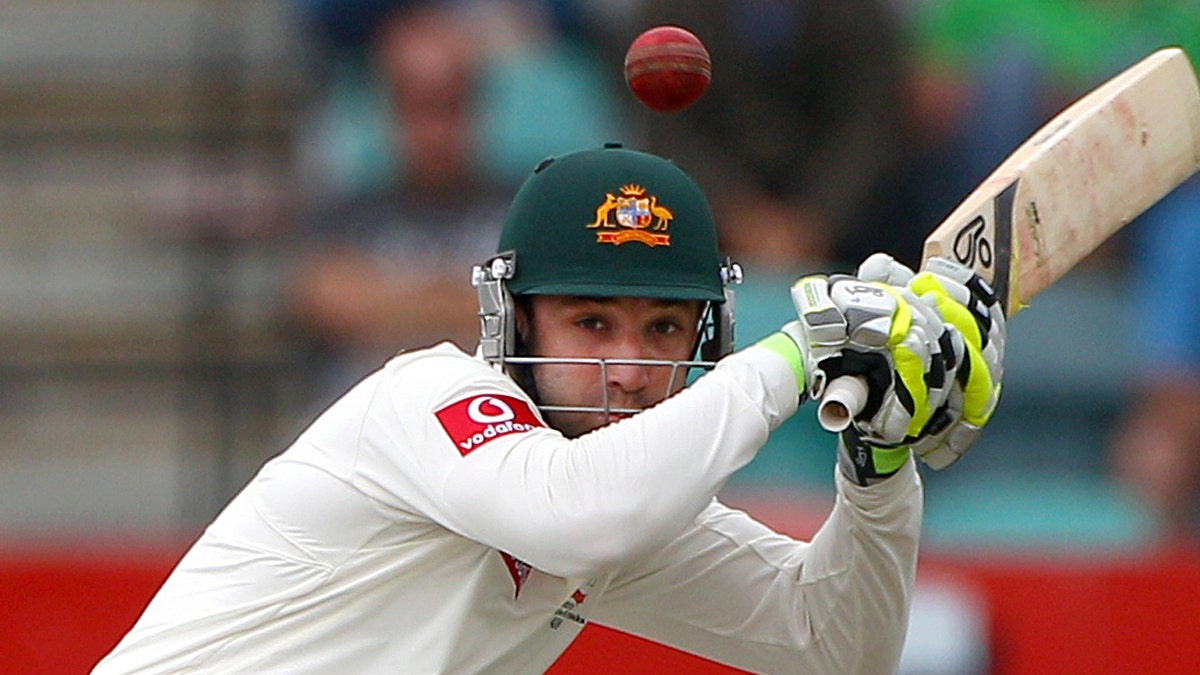
Dec. 14, 2014: Australia's Phil Hughes ducks under a bouncer from Sri Lanka's Shaminda Eranga on the first day of their cricket test match at Bellerive Oval in Hobart (AP)
SYDNEY – Australian cricketer Phillip Hughes died Thursday from a "catastrophic" injury to his head, two days after being struck by a delivery during a match.
Australia captain Michael Clarke, trying to compose himself several times, read a brief statement on behalf of Hughes' parents, brother and sister at a news conference at St. Vincent's Hospital that was broadcast live around Australia.
"We're devastated by the loss of our much-loved son and brother Phillip. Cricket was Phillip's life, and we as a family shared that love of the game with him ... We love you," Clarke read, holding back tears before leaving the room.
Hughes was wearing a helmet Tuesday when he was hit after attempting to hook a short-pitch ball from New South Wales fast bowler Sean Abbott.
Dr. Tony Grabs, a surgeon and director of trauma services who treated Hughes at St. Vincent's, said the 25-year-old cricketer had died from a rare injury — there have been only 100 documented cases of vertebral artery dissection — which resulted in severe bleeding on his brain.
"We did a CAT scan of the head to determine what we could do," Grabs said. "This occurred very early and it was recognized we had to make an intervention to help get the pressure down in the brain. He had extensive surgery to remove some of the skull from around his brain to help allow the brain to expand so it wasn't compressed."
Australian team doctor Peter Brukner said Hughes' recovery did not go as hoped.
"Over a period of the first 24 to 48 hours he did not make very much improvement and unfortunately, as a consequence of the injury, he died," Brukner said.
Cricket Australia chief executive James Sutherland said Hughes was immensely talented and dearly loved: "Without doubt, he was a rising star whose best cricket was still ahead of him."
"The word tragedy gets used too often in sport, but this freak accident is real life tragedy," Sutherland said. "Just days short of his 26th birthday, Phillip has been taken away from us too soon. He will forever be remembered as one of the elite few to have worn the baggy green cap, cap number 408."
Also at the news conference, doctors said Hughes was in the care of two specialist doctors before an ambulance and paramedics arrived at the Sydney Cricket Ground, making their delayed response less relevant, Brukner said. It took two phone calls and 15 minutes for an ambulance to get to an unconscious Hughes.
"I think ambulance waiting time is really more relevant when the injured person is not being treated," Brukner said. "I think by any standard or observation, he was receiving excellent quality treatment. Hence, he arrived at the hospital in excellent condition."
Brukner announced the death earlier Thursday in a statement, saying Hughes never regained consciousness. The statement was issued shortly after Australian opener David Warner, one of the first players to help Hughes when he collapsed on the field, had left the hospital in tears.
Hughes' mother and sister were at the match when he was he was hurt, and kept vigil at the hospital. Clarke, a close friend, was among dozens of former and current teammates and stars of the game who visited the hospital to offer their support.
Prime Minister Tony Abbott described Hughes as a "young man living out his dream," adding "it's a very sad day for cricket and a heartbreaking day for his family."
Messages of support poured in from all around the world after Hughes stumbled, leaned over and then collapsed after being hit behind the left ear when he mis-timed a short-pitch delivery while batting for South Australia against New South Wales in a Sheffield Shield match.
Deaths are rare in cricket, although Hughes is the second player in two years to sustain a fatal blow.
Darryn Randall, who was 32 and a former first-class player in South Africa, was killed after being struck on the side of the head during a Border Cricket Board Premier League match in the Eastern Cape last year.
At the Australian Open golf tournament not far from St. Vincent's, a large gallery following Adam Scott heard of Hughes' death and some wiped tears from their eyes.
Hughes played 26 test matches for Australia after making his debut in 2009, but despite a sparkling start to his international career at 19, he was not able to earn a regular spot in the starting lineup.
After making 75 in his first test innings against South Africa in Johannesburg, he posted centuries in each innings of his second test, becoming the youngest player ever to do that in test cricket. But he struggled on the subsequent tour of England and was in and out of the Australian team four more times. He was on the verge of another test recall when he was fatally struck.
The injury sparked debate about short-pitch bowling in the game.
Bouncers, where a fast bowler aims to push the batsman back toward the stumps with a ball that lands halfway down the pitch and rears up above chest or head height, are still a regular and acceptable part of the game.
The International Cricket Council revised its laws on short-pitch bowling in the early 1990s, putting restrictions on the number of short-pitch balls allowed per over to stamp out bowlers merely using the delivery to intimidate batsmen.
Sutherland said Sean Abbott was being counseled, had visited Hughes in the hospital and had been consoled by Clarke and members of Hughes' family.




















